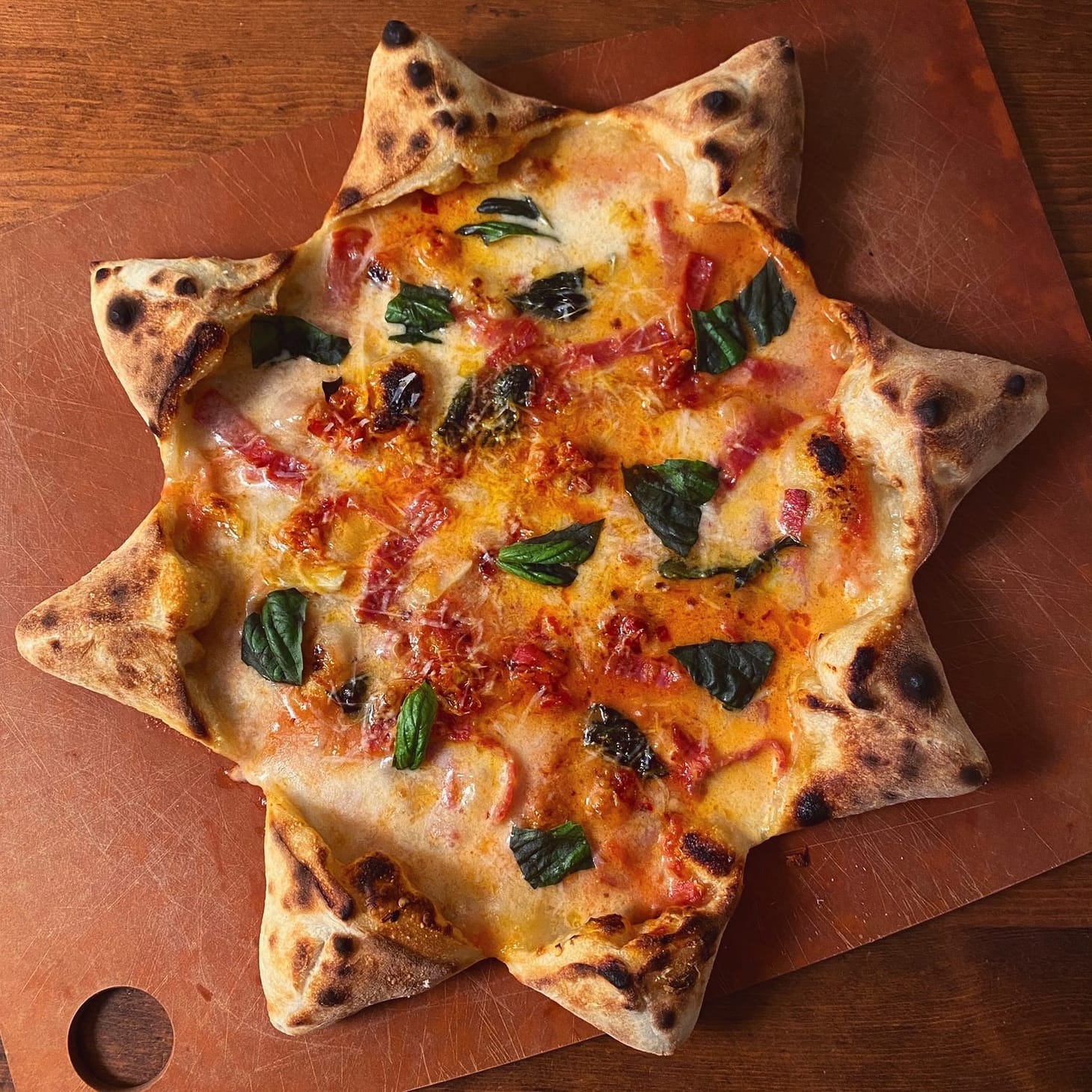Recipe: Sourdough Thin Crust Pizza Dough
Into the wild, at last

Table of Contents

Full disclosure: I have never really been a big fan of sourdough pizza crusts, and have resisted the project of creating a recipe for one for years. I am very picky about the texture of my pizza crusts—I want them to be light and crisp, above all. While chewy is usually nice, any hint of toughness and I’m bound to be disappointed. And all of the sourdough crusts I’d eaten up until now—mine or otherwise—have not been up to snuff.
But it remained something that I wanted to figure out, and I think I finally have. One of the things I realized this time around is that—owing to the extra acidity that sourdough imparts to a dough—you don’t really want to use super strong flours, or the crust will be unpleasantly tough. When I first sent this out to my crack team of peer testers, I said it could be made with either high-protein all-purpose, bread, or high-gluten flour, but I continued to test it myself and decided that a moderate amount of protein is best to keep the crust crisp, light, and moderately chewy. (In the headnote, I say you can substitute bread flour for the high-protein AP or OO flour. In this case, I mean lower protein bread flours like Gold Medal or Pillsbury, which are pretty close to King Arthur AP. I assume that if you can find KA bread flour you can also find KA all-purpose.)

This recipe is similar to my NYC thin-crust yeasted formula, with some notable differences beyond just the use of sourdough:
For one thing, it includes a little whole grain flour, sifted to remove the bran, for a boost of grainy flavor. (By the by, the formula works beautifully using 100% high-extraction bread flours such as my favorite local flour from Ground Up Grain in Hadley, MA.)
Two, it’s made with room-temperature water, hand-mixed, and fermented at room temperature for a few hours with 2 sets of coil folds—see below for a GIF on how I do my coil folds—before dividing and transferring to the fridge. Unlike with yeasted ones, sourdough pizza doughs need a few hours at room temperature to spark fermentation before cooling them down. Because of that, it’s just as easy to make it by hand. (Keep in mind that—just as with the yeasted pizza dough—you won’t really see any activity in the dough before moving it to the fridge.)
The dough will get more sour the longer it sits in the fridge. And more slack. I say “24 to 96 hours” here, since I think that’s the window during which the dough is at its best. But have cooked it successfully after 5 days of cold storage, though it was slack enough that someone with limited experience might have difficulty shaping it well.
Finally, I recommend letting the dough balls start to puff up a little bit before stretching, since I think this style of pie benefits from more spring than a NYC pizza.

[Photo and pizza credit: Rhianna Morris]
I want to thank each and every one of the people that tested this recipe out for me. I made several key changes to the formula and corrections to the recipe based on their thoughtful, detailed notes. And, most importantly, I received essential feedback on the recipe itself, which everyone seemed to like, at least once I worked out all the kinks. Along with glowing reviews, like this one from Rhianna Morris, whose own pie photos—including that incredible star pie—accompany this post:
I am totally in love with this formulation. Best pizza I've ever made for my tastes.
Can’t really improve upon that…
—Andrew
Sourdough Thin Crust Pizza Dough
Makes two 12-inch pies (dough weight 375g each)
King Arthur all-purpose flour or Caputo OO pizza flour is ideal here; if unavailable, use bread flour. Sift the rye or wheat flour through a fine-meshed sieve before measuring to remove bran; if unavailable, substitute an equal weight of white flour you are using. Diastatic malt powder is optional, but will help improve crust color and flavor and is highly recommended. It can be purchased online and it will keep for a long time if kept in a tightly-closed container; malt sugar or malt syrup are not suitable substitutes. If your levain is mature, you can use cold-stored, recently-refreshed levain directly in this recipe; if not, use levain that has been refreshed and allowed to at least double in volume, 4 to 6 hours.
Overall:
95% high-protein all-purpose or OO flour
5% sifted whole-grain flour
1% diastatic malt powder
65% water (75˚F)
2% olive oil
2.2% salt
25% levain/12% prefermented flour
Final mix:
370g high-protein all-purpose or OO flour
22g sifted whole-grain flour (2-1/2 tablespoons)
4g diastatic malt powder (1-1/4 teaspoons)
235g water (75˚F), divided
100g 100% hydration levain
9g olive oil (2 teaspoons)
10g salt (2 teaspoons table)
Place water in medium bowl; scoop out about 1 tablespoon (~15g), transfer to small bowl, and set aside. Add levain and oil to remaining water and stir to combine. Add half of flours and diastatic malt to water-oil mixture and stir with dough whisk or wooden spoon until evenly mixed and no dry flour remains. Add remaining flour mixture and stir until mostly combined. Working in bowl, knead dough by hand until evenly mixed and no dry flour remains. Cover and let sit 30 minutes.
Add reserved water and salt to top of dough and knead by hand in bowl until thoroughly combined and even in texture, 1 to 2 minutes.
Desired dough temperature: around 78˚F.
Cover and let sit for 2 hours at room temperature (dough will not rise appreciably during this time). During this time, using wet hands, do 2 sets of coil folds at 45 and 90 minutes.

Knead dough on well-oiled counter until even in texture (dough will remain slightly rough). Divide into two 375g portions and shape into tight, smooth balls (pinch seams thoroughly closed). Coat each ball lightly with oil, and transfer seam-side down to lightly-oiled containers (or a baking sheet sprayed with oil and covered well with plastic wrap). Refrigerate for 24 to 96 hours.
At least one hour before baking pizzas, adjust oven rack to first- or second-highest position (rack should be about 4 to 5 inches below broiler element), set baking stone or steel on rack, and heat oven to 500 or 550 degrees. Remove container(s) of dough from refrigerator and let stand until no longer chilled and very slightly puffy, 45 to 120 minutes.
Coat 1 ball of dough generously with flour by dipping both sides of it in a bowl of flour and place on lightly-floured countertop, seam- (i.e., bottom) side up. Using fingertips, gently flatten into 8-inch disk, leaving 1 inch of outer edge slightly thicker than center. Using hands, gently stretch disk into 11-inch round, working along edges and giving disk quarter turns as you stretch. Transfer dough to well-floured peel, Super Peel, or parchment on peel and stretch into 12-inch round.
Top (1/3 to 1/2 cup sauce sauce and 60 to 120g cheese) and bake until crust is well browned and cheese is bubbly and beginning to brown, 5 to 10 minutes, rotating pizza halfway through.
Serve immediately and repeat with remaining ball of dough.
wordloaf Newsletter
Join the newsletter to receive the latest updates in your inbox.




